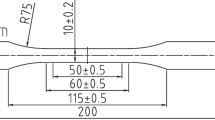Abstract
Blending cyanate ester (CE) with epoxy resins offers the possibility to manufacture radiation resistant insulations at a low price compared to pure CE materials. Therefore, it is of special interest to study the influence of the CE content and also the effect of catalyst on the curing behavior of these insulation systems. Here, we present the curing behavior of the CE–epoxy blend system studied by non-isothermal differential scanning calorimetry in combination with Fourier infra red (FTIR) spectroscopy. Effect of amount of catalyst, compositional change, heating rate on the conversion, and enthalpy change were studied. The activation energy (E a) and pre-exponential factor (A), rate constant of different blend systems with and without catalyst, were computed from the modified Ozawa and Kissinger model equations using isoconversional methods. Studies suggested that cure-kinetic parameters calculated from both the models are found to be matching. It was observed that the activation energy is less in the case of catalyzed system than the uncatalyzed system. Predicting the cure profile of this resin system is important under a given set of conditions for achieving the desired, controlled polymerization. This is the first report on the studies of the cure-kinetic parameters of the CE–epoxy blend system, and these observations will definitely pave the way for tuning the process parameters and temperature profile for achieving the desired properties of these insulation systems in fusion relevant magnetic winding packs.











Similar content being viewed by others
References
Koizum N, Hemmi T, Matsui K, Nakajimaa H, Okunoa K, Kunob K, Nomotob K. Critical issues for the manufacture of the ITER TF coil winding pack. Fusion Eng Des. 2009;84:210–4.
Hamerton I, Hay JN. Recent technological development in cyanate ester resin. High Perform Polym. 1998;10:163.
Nair CPR, Mathew D, Ninan KN. Cyanate ester. Adv Polym Sci. 2001;155:1–99.
Herr DE, Nkolic NA, Schultz RA. Chemistries for high reliability in electronics assemblies. High Perform Polym. 2001;13:79.
Fang T, Shimp DA. Polycyanate esters: science and application. Prog Polym Sci. 1995;20:61–118.
Hamerton I. Chemistry and technology of cyanate ester resins, Chap. 3. Glasgow: Chapman & Hall, p. 77, 128, 173; 1994.
Hamerton I, Herman H, Mudhar AK, Chaplin SJ. Studying water uptake effects in resins based on cyanate ester/bismaleimide blends. Elsevier Polym. 2000;41:1647–56.
Grigat E, Putters R. Synthesis and reactions of cyanate ester. Angew Chem Int Ed. 1967;6:206–18.
Grenier-Loustalot MF, Lartigau. Molten state reactivity of difunctional cyanates: thermal and spectroscopic studies by liquid and solid CP-MAS 13C-NMR. J Polym Sci. 1997;35:3101.
Fyfe CA, Niu J, Rettig SJ, Wang DW, Poliks MD. NMR investigations of the possible cross reactions between cyanate and epoxy resin. J Polym Sci. 1994;32:2203–21.
Mathew D, Nair CPR, Ninan KN. Bisphenol A dicyanate–novolac epoxy blend: cure characteristics, physical and mechanical properties, and application in composites. J Appl Polym Sci. 1999;74:1675–85.
Santhosh Kumara KS, Reghunadhan Nair CP, Ninan KN. Investigations on the cure chemistry and polymer properties of benzoxazine–cyanate ester blends. Eur Polym J. 2009;45(2):494–502.
Coutinho FMB, Rocha MG. Kinetic study of the reaction between a hydroxylated polybutadiene and isocyanates in chlorobenzene. III. Reaction with dimer diacid diisocyanate (DDI). J Poly Sci. 1988;26:3167–73.
Ramis X, Salla JM, Cadenato A, Morancho JM. Thermal analysis of polyolefin and liquid paraffin mixtures. J Therm Anal Calorim. 2003;72:707–11.
Vinnik RM, Roznyatovsky VA. Kinetic method by using calorimetry to mechanism of epoxy-amine cure reaction. J Therm Anal Calorim. 2004;75:753–5.
Senger JS, Yilgor I, McGrath JE, Patsiga RA. Isocyanate–epoxy reactions in bulk and solution. J Appl Polym Sci. 1989;38:373–82.
Tanzer W, Much H, Ruhmann R. Reaktionen poly poly funktionellen glycidthern. 1. Identifizierang der gebideten strukturemenate. Acta Polym. 1989;40:335–40.
Chu F, Mckenna T, Lu S. Étude par DSC de la reticulation de systems DGEBA/polyacides. Eur Polym J. 1997;33:969–75.
Inaki M, Lorena S, IIeana BR. Cure kinetics of a cobalt catalyzed dicyanate ester monomer in air and argon atmospheres from DSC data. Thermochim Acta. 2004;417:19–26.
Prime RB, Turi EA. Thermal characterization of polymeric materials. New York: Academic Press; 1997. p. 1380–17440.
Florence M, Loustalot G, Lartigau C. Influence of the stoichiometry of epoxy-cyanate systems (non catalyzed and catalyzed) on molten state reactivity. J Polym Sci A. 1997;35:3101–15.
Mathew D, Nair CPR, Krishnan K, Ninan KN. Catalysis of the cure reaction of bisphenol A dicyanate: a DSC study. J Polym Sci A. 1999;37:1103–14.
Martín JL, Cadenato A, Salla JM. Comparative studies on the non-isothermal DSC curing kinetics of an unsaturated polyester resin using free radicals and empirical models. Thermochim Acta. 1997;306:2115–26.
Simon SL. Non-isothermal DSC curing kinetics. Thermochim Acta. 2007;415:2125–47.
Bauer J, Bauer M. Statistical structural model for the gelation behaviour of cyanate–epoxy polyreactions. Acta Polym. 1988;39:548–51.
Margit H, Karger-Kocsis J, Holst M. Influence of fillers and additives on the cure kinetics of an epoxy/anhydride resin. Eur Polym J. 2007;43:168–1178.
Bauer M, Bauer J, Ruhmann R, Kuhn G. Reaktionen poly funktioneller cyansaureester mit poly funktionellen glycidthern Reacktions model. Acta Polym. 1989;40:397–401.
Senger JS, Yilgor I, McGrath JE, Patsiga RA. Isocyanate–epoxy reactions in bulk and solution. J Appl Polym Sci. 1989;38:373–82.
Liu H, George GA. Studies on the gelation of photocatalysed dicyanate ester resins. Polymer. 1996;16:3675.
Lopez M, Blanco M, Vazquez A, Ramos JA, Arbelaiz A, Echeverria JM, Gabilondo N, Mondragon I. Isoconversional kinetic analysis of Resol-clay nano-composites. J Therm Anal Calorim. 2009;96:567–73.
Sheng X, Akinc M, Kessler MR. Cure kinetics of thermosetting bisphenol E cyanate ester. J Therm Anal Calorim. 2008;93:77–85.
Acknowledgements
We thank the Institute for Plasma Research, Bhatt, Gandhi agar, Gujarat 382428, India (GAP 132539) for the financial support. The authors are grateful to Director, NIIST, CSIR, Trivandrum, and Director, IPR, Gujarat, Dr. A. Ajayaghosh, Head, CSTD, NIIST, CSIR, TVM, for their constant encouragement and support.
Author information
Authors and Affiliations
Corresponding authors
Rights and permissions
About this article
Cite this article
Pradhan, S., Brahmbhatt, P., Sudha, J.D. et al. Influence of manganese acetyl acetonate on the cure-kinetic parameters of cyanate ester–epoxy blend systems in fusion relevant magnets winding packs. J Therm Anal Calorim 105, 301–311 (2011). https://doi.org/10.1007/s10973-011-1487-8
Received:
Accepted:
Published:
Issue Date:
DOI: https://doi.org/10.1007/s10973-011-1487-8




